To visit Pianosa
The island of Pianosa is only 7 nautical miles equal to 12 km and 964 meters far from the tip of Fetovaia, therefore it turns out to be the closest island of Elba, among the islands of the Tuscany Archipelago, which you can reach in only 35 minutes of navigation leaving from the port of Marina di Campo in the municipality of Campo in Elba, to which it administratively belongs.
After a century and half in which it was destinated as penal colony, Pianosa has opened its doors to the visitors again, offering them a unique, splendid and absolutely intact atmosphere. The silence, the colours, the crystalline sea, the walls, the phantasmagoric cliffs, the jails, the spontaneous blooms, the sun striking in every angle, from the dawn to the sunset: these are all elements characterizing the Pianosa Island. The presence of the prisoners, before for will of the grand dukes from Tuscany and then of the Italian Republic, has indeed pushed away the mass tourism, protecting the ecosystem of Pianosa from the mockery of the tourism industry.
Unique among the Tuscany islands to being entirely flat, Pianosa is a true paradise for the visitors who pay attention to the cultural and environmental values, and offers an incredible historical, archaeological and naturalistic heritage. For whom willing to visit it, he/she can do it thanks to the prepared and expert environmental tourist guides, who will lead you to the discovery of this wonderful island with complete explanations. The island is under the protection of the national Park of Tuscany Archipelago, and is possible to visit it both for a bathing day delimited in the waters of Cala Giovanna,and for carrying out an excursion in bicycle between the flat lanes which cross the perfumed and low forests of the Mediterranean scrub.
Other possible excursions and sport activities guided to Pianosa are trekking, sea kayak where it is possible to circumnavigate the island and to see the coastal features with the most beautiful bays, or to amuse yourself at sea making snorkelling and observing the rich fauna and marine flora of the island.
A “must-see” is the view upon the splendid bay of Porto Romano earning the north tip of the island, behind the ruins of the Marchese. Equally evocative are the colours of the reef which connects Punta del Marchese and Punta di Libeccio, where the yellow, ochre and ivory shadings hide marine fossils remained imprisoned in the last ages.
The paradise of the naturalists hides treasures still more amazing under uncontaminated waters of the sea with coves and canyons, roman amphoras and red corals. Groupers, dentexes and seagrass, glances, sea basses and giant goatfish are only some of the living beings which live the waters of this ecosystem of extraordinary archaeological and ecological value, which the historical and political events, in more or less intentional way, have conserved intact. The limestone sea bottoms of Pianosa exalt much more the colours of a water which would make the innkeepers of the Caribbeanses get envious. In order to realize that, it is enough to equip oneself with a very simple mask and to dip the head under the waters of Cala Giovanna, the only zone of the island where bathing is allowed. In Pianosa anchorage, fishing, immersion and navigation are prohibited, as they would irreparably destroy this natural oasis acting also as unit of the maternity for many species to extinction risk, or however threatened by the nefarious consequences of the human progress.
In order to symbolize the function of Pianosa and the will of the naturalists of protecting and valuing this jewel of the Archipelago, in August 2000 three specimens of common marine turtle were set free, hoping to find new spaces in order to place eggs along the coasts of the Archipelago.
For visiting Pianosa it is necessary to address to the Agency Park of the Tuscany Archipelago or to the municipality of Campo in Elba, where reservations are received.
In the small space of the cape of the Teglia they are concentrated the village of Pianosa with the former prison buildings and the structures of the small port, defined many times by the experts of sea like "the most beautiful of the world". Around the small river basin, delimited by a wharf which can contain maximum about ten boats, a very small village of small crenellated houses crowds around, restored recently. Moreover, a little hotel, attended until recent years by the relatives of the prisoners, is today requalified and allows the overnight to a limited number of hosts.
On the small port the Forte Teglia dominates, which Napoleon made build. To the left of the small port, through a small cove you can enter the catacombs extended with a thick net of underground tunnels for approximately 200 meters. Perhaps they go back to the end of the IV century and have been attended for a long time. Restored by the Papal Commission of sacred Archaeology, they are still object of digging, study and recovery by the papal archeologists. To short distance from the small port of Elba, in the sea the limestone size of the little island of Scola erects, encircled by beautiful pastures submergeed by poseidonia and by rocky sea bottoms which fall towards 50 meters of depth. The reef is seat of interesting endemic species which, alone, justify their own protection. On the little island of Scola the most numerous colony of the biggest shearwater from Tuscany Archipelago lives. Opposite the small island the very beautiful Cala dei Turchi opens, with indented coasts and transparent waters. The only accessible beach of the island of Pianosa is that of the splendid Cala Giovanna, just north of the cape of the Teglia, a very fine white sand beach which borders a sea from crystalline waters. Behind the Cove the imposing wall dominates, which the General Dalla Chiesa made build in the 1970s to early 1980s when Pianosa became a maximum security prison for goodfellas and terrorists.
Cala Giovanna, the only beach of Pianosa where bathing is allowed, connects the village to the baths of Agrippa. To the north limit of the Cala Giovanna, by the sea, you can see the ruins of a sumptuous roman villa of the I century. It was the splendid dwelling of Mark Vipsanio Agrippa, grandson of August, exiliated to Pianosa and then murdered in order to concur the succession of Tiberius. The ruins characterize a rather important complex of buildings, supplied also of a small circular theatre of which it is still possible to see the flight of steps. In the articulated plant of the complex, different atmospheres can be recognized between which the dock, the fish market, the marine and termal bath. Some halls were decorated with marble floors, stucco walls, statues and refined mosaics.
Elbaworld suggests

What to visit
Discover places and attractions nearby.

Recommended excursions
Discover incredibly beautiful excursions on Elba Island.













